Kazakhstan Plans to Establish State Crypto Reserve

Kazakhstan’s National Bank is developing plans to establish a state-managed cryptocurrency reserve, officials announced this week, marking a significant move toward centralized oversight of digital assets in the country. National Bank Chairman Timur Suleimenov disclosed the proposal in response to a parliamentary inquiry. According to Suleimenov, the concept is under detailed examination, including the possibility of housing the reserve within an affiliate institution of the National Bank. Centralized Model Aims to Reduce Risk Suleimenov emphasized the need for a centralized and institutionalized approach to crypto-asset management, citing volatility and security risks as primary concerns. He noted that central oversight would be the “main guarantee” of asset safety and management integrity. The initiative follows Kazakhstan’s broader move toward regulating the domestic cryptocurrency sector, with the National Bank expected to play a leading role. The bank is studying global models for managing sovereign crypto reserves, including the use of digital assets obtained through legal expropriation or mined through state-partnered operations. Officials say the state reserve could function similarly to traditional sovereign wealth funds, using blockchain-based assets rather than fiat currencies or physical commodities. Kazakhstan Legal and Regulatory Framework Still in Progress The mechanism for creating and managing the reserve is still in development and will involve collaboration with law enforcement agencies and other relevant state bodies. Suleimenov did not provide a timeline for implementation but stressed that policy planning would prioritize legal compliance and financial stability. The proposal aligns with the Kazakh government’s ongoing efforts to formalise its approach to cryptocurrencies. In recent years, the country has attracted crypto miners with its relatively low energy costs, though regulatory uncertainty has remained a challenge. Earlier this year, Kazinform reported that the National Bank had begun drafting regulations aimed at overseeing cryptocurrency activity more broadly, signalling a shift from passive observation to active engagement in the digital finance space. Kazakhstan joins a small group of countries exploring the use of digital assets within sovereign financial frameworks. As international interest in crypto governance grows, the country’s experience may serve as a model for similar initiatives elsewhere.
Are Crypto Cards Safer Than Credit Cards?
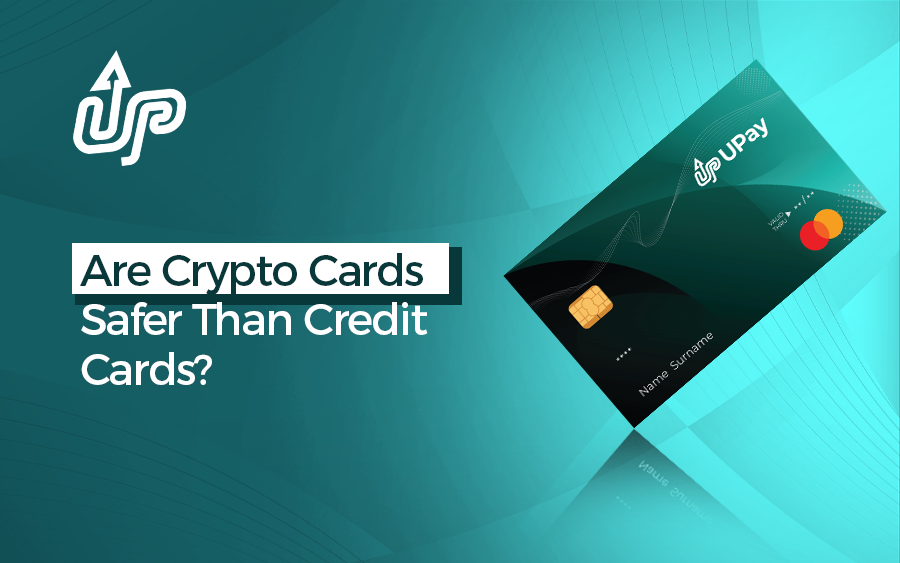
Cryptocurrency has made significant strides in the global financial landscape, yet its widespread adoption still faces hurdles. Many governments and businesses remain hesitant to embrace digital assets, creating challenges for everyday use. To help bridge this gap, innovative tools like crypto cards have emerged. These cards enable users to spend cryptocurrency for daily purchases by automatically converting it into fiat currency at the point of sale. So, are crypto cards safer than credit cards? The safety of crypto cards versus traditional credit cards isn’t a simple yes or no. While crypto cards benefit from blockchain’s security features, such as decentralization and immutable transaction records, most operate on the same payment networks, such as Visa or Mastercard, and are subject to similar vulnerabilities during point-of-sale transactions. Meanwhile, credit cards benefit from decades of regulatory oversight, fraud protection systems, and consumer protections like chargebacks. This article explores the security features, potential risks, and best practices for using crypto cards to help you understand how they stack up against traditional credit cards. What Are Crypto Cards? Crypto cards function similarly to traditional debit or credit cards but are designed to facilitate transactions using cryptocurrency. These cards are typically issued by cryptocurrency platforms in collaboration with major payment networks like Visa and Mastercard. They allow users to spend their digital assets at merchants that accept traditional card payments, with the cryptocurrency being automatically converted to fiat currency (e.g., USD, EUR) at the point of sale. Types of Crypto Cards Read Also: Can You Use Crypto Credit Cards Anywhere? Are Crypto Cards Safer Than Traditional Credit Cards? Source: FreePik The safety of crypto cards compared to traditional credit cards depends on several factors. Here’s a breakdown of key differences: 1. Fraud Protection Credit Cards: Crypto Cards: 2. Exposure to Theft Credit Cards: Crypto Cards: 3. Privacy & Anonymity Credit Cards: Crypto Cards: 4. Security Features 5. Currency Risk Credit Cards: Crypto Cards: Verdict: Crypto Cards vs. Credit Cards Source: FreePik Feature Crypto Cards Credit Cards Security High (2FA, cold storage, decentralized) Moderate (vulnerable to breaches, identity theft) Fraud Risk Low (irreversible transactions, no personal banking data) High (susceptible to data breaches, chargeback fraud) Usability Limited (only accepted at specific merchants) Universal acceptance Fees Varies (exchange fees, withdrawal limits) Interest rates, foreign transaction fees Rewards Crypto cashback, staking rewards Cashback, travel points Expert Tips for Using Crypto Cards Safely Source: FreePik To maximize the security and benefits of crypto cards, it’s crucial to be aware of potential risks and take proactive measures. Related: Cryptocurrency Wallets: Virtual Crypto Cards vs. Debit Cards Conclusion Crypto cards represent a significant innovation in the financial world. They serve as a bridge between the growing cryptocurrency market and everyday transactions. Crypto cards offer a secure and innovative way to spend cryptocurrency. However, their safety and practicality compared to traditional credit cards remain a topic of debate. Crypto cards boast advanced security features such as encryption, tokenization, two-factor authentication (2FA), and decentralized transactions, which reduce the risk of fraud and data breaches. However, crypto cards are not without risks. The irreversible nature of cryptocurrency transactions means that any mistakes or thefts can result in permanent loss of funds. Traditional credit cards, on the other hand, have decades of development in fraud prevention and consumer protection. Nonetheless, they are also not immune to risks, as centralized systems are prime targets for large-scale data breaches and identity theft. Ultimately, the choice between crypto cards and traditional credit cards depends on the user’s comfort with technology, their understanding of cryptocurrency, and their specific financial needs. For tech-savvy individuals who value decentralization and control over their funds, crypto cards can be a secure and innovative option. For those prioritizing convenience and widespread acceptance, traditional credit cards remain the better choice. FAQs
How To Calculate Crypto Profit: A Step-by-Step Guide For Everyone
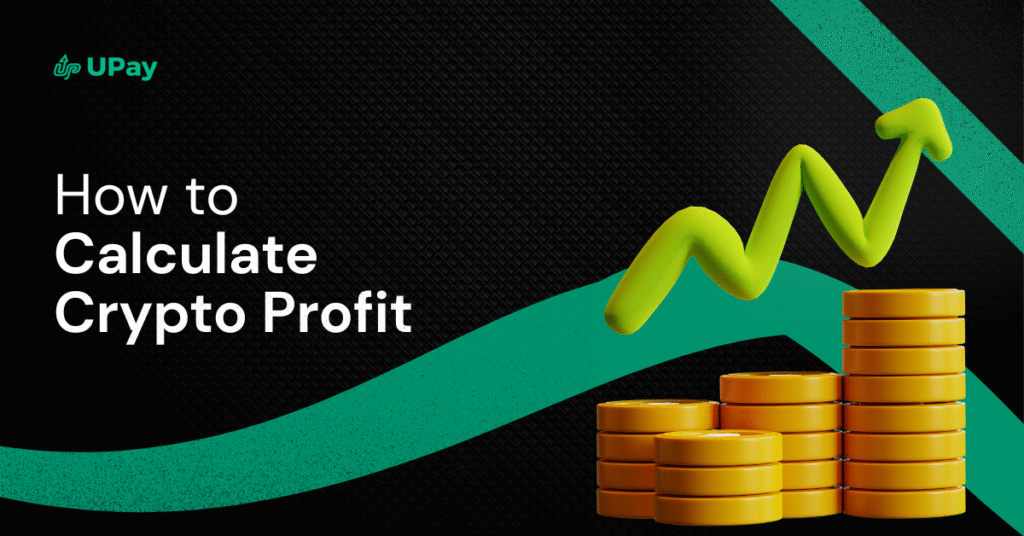
With volatile prices and multiple transactions clouding the picture, calculating your crypto profit can feel like navigating a complex maze. But here’s a striking fact: over 75% of cryptocurrency investors experience losses. As such, it is a big deal when you make profit in your crypto trade. So if you’re ready to take control and learn how to calculate your crypto profit with simple tips anyone can follow, you’ve come to the right place. This guide breaks down everything you need to know so you never lose track of your hard-earned gains again. Key Takeaways Why Calculating Your Crypto Profit Is Important Your crypto profit offers you financial gain through buying and selling cryptocurrencies. It’s the difference between what you paid for your crypto assets (your cost basis) and the amount you receive when you sell or exchange them. This profit can be realized or unrealized. When it is realized, this means you’ve sold your assets and locked in the gain. It also reflects the current value of your holdings if you haven’t sold yet. Calculating your crypto profit helps you measure how successful your investments are and guides your future decisions. It also helps you understand the actual performance of your investments, so you can make informed decisions about buying, selling, or holding assets. Accurate profit calculation is essential for tax reporting, as some countries treat crypto gains as taxable income or capital gains. So, failing to calculate profit correctly can lead to overpaying taxes or facing penalties. Knowing your profit helps you track your financial goals and optimize your investment strategy over time. Types of Crypto Investments There are different ways you can choose to invest in cryptocurrency. This guides how profits are made and calculated. Each investment type involves unique strategies, risks, and profit potentials. Buying and Holding (HODL) This strategy involves purchasing cryptocurrencies and holding onto them for the long term, regardless of short-term market fluctuations. Investors believe in the asset’s potential growth over time and aim to sell when prices peak, realizing significant profits. Calculating profit here is often straightforward: the difference between the purchase price and the sale price. However, it requires patience and market awareness. Trading (Day Trading, Swing Trading) Trading involves buying and selling cryptocurrencies over shorter periods to capitalize on market volatility. Day trading focuses on quick trades within a single day, while swing trading holds assets for days or weeks to catch price swings. Profits come from frequent transactions, making tracking gains and losses more complex due to many trades and transaction fees. Staking and Yield Farming Staking involves locking up cryptocurrencies in a network to support blockchain operations, earning rewards in return. Yield farming is similar but usually involves lending or providing liquidity in decentralized finance (DeFi) platforms to earn interest or tokens. Profits from these activities include rewards plus any appreciation in token value, which can complicate profit calculations. How Crypto Prices Affect Profit Cryptocurrency prices are highly volatile, changing rapidly due to market demand, news, regulations, and broader economic factors. This volatility means your crypto profit can fluctuate daily. So, unrealized profits can quickly turn into losses if prices drop. Monitoring price trends and timing your trades or sales is key to maximizing profit. Additionally, price changes affect the valuation of staking rewards and yield farming returns, making real-time tracking important. Key Concepts to Calculate Your Crypto Profit Before calculating your crypto profit, it’s important to understand several fundamental concepts that affect how profits are measured and reported. Cost Basis Cost basis is the original value or purchase price of your cryptocurrency, including any fees or commissions paid during acquisition. It serves as the starting point for calculating profit or loss. For example, if you bought 1 Bitcoin for $100,000 and paid $200 in fees, your cost basis is $100,200. Knowing your accurate cost basis is essential because it determines how much you’ve actually invested and helps calculate your true gains. Knowing the difference helps you track your actual profits versus potential profits, aiding in better decision-making and tax planning. Fees and Taxes Transaction fees, such as exchange fees, network (miner) fees, and withdrawal fees, reduce your overall profit. Ignoring these fees can lead to overestimating your earnings. Similarly, taxes can significantly impact net profit. Different countries have varying rules for taxing crypto profits, including short-term vs. long-term capital gains rates, and sometimes specific reporting requirements for crypto trades, staking rewards, or airdrops. Keeping track of fees and understanding your tax obligations ensures your profit calculations are realistic and compliant with the law. Step-by-Step Guide to Calculate Your Crypto Profit Calculating your crypto profit may seem overwhelming at first, but breaking it down into clear steps makes the process manageable and accurate. Step 1: Gather All Transaction Data The first step is to collect every transaction you’ve made involving cryptocurrency. This includes purchases, sales, trades, transfers, staking rewards, and airdrops. Step 2: Calculate Your Total Cost Basis Your total cost basis is the sum of all amounts spent to acquire your cryptocurrency, including purchase price and any related fees (exchange fees, network fees, commissions). Accurate cost basis calculation ensures your profit or loss reflects the true amount you invested. Step 3: Calculate Your Total Revenue Your total revenue is the amount you received when selling or exchanging your cryptocurrency, minus any fees associated with those transactions. Step 4: Determine Your Net Profit or Loss Finally, calculate your net profit or loss using the simple formula:Profit = Total Revenue – Total Cost Basis Methods to Calculate Your Crypto Profit Several approaches are available for calculating your crypto profit, ranging from manual methods to automated tools designed to handle complex transactions. Manual Calculation Using Spreadsheets You may want to start with spreadsheets to track buys, sells, fees, and calculate profit manually. This method allows customization but requires careful record-keeping and basic math skills. You’ll need to input all transaction details and use formulas to compute cost basis, revenue, and net profit. Spreadsheets are best for investors with a
What Are the Fastest Ways to Swap Meme Tokens in 2025?
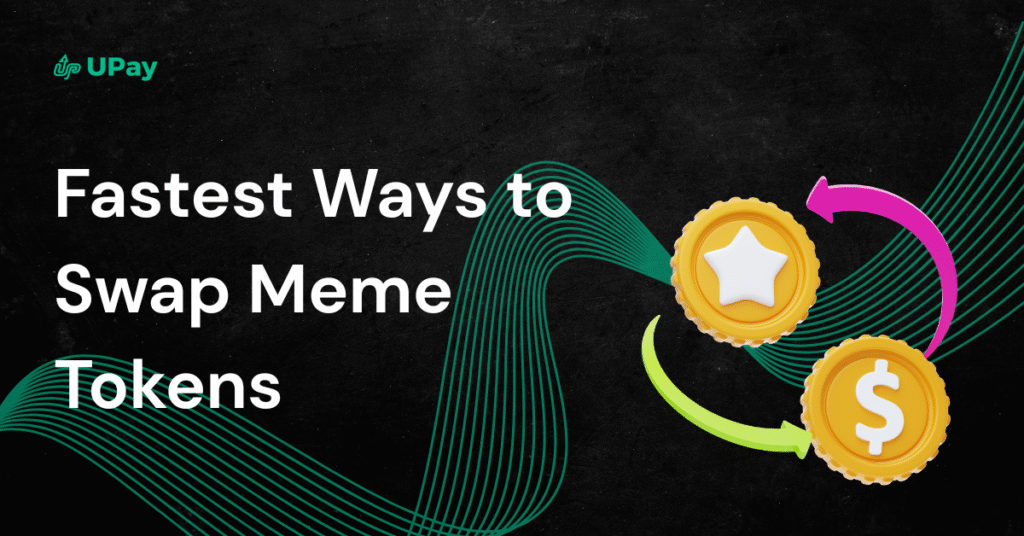
Many traders watch meme tokens skyrocket in value within minutes, only to be stuck waiting for slow transaction confirmations, dealing with high slippage, or facing failed swaps due to congested networks. This can be especially frustrating when trying to jump into a trending token like Trump or Brocolli only to miss the rally because your ETH or SOL didn’t convert in time. These delays are often caused by high demand, poor liquidity routing, or choosing the wrong platform at the wrong moment. Whether you’re using a DEX, CEX, or aggregator, every second counts when trading meme coins. If you’ve ever been left holding ETH while your target coin doubled in price, you’re not alone. In this article, we’ll examine the fastest ways to swap meme tokens using the right tools, platforms, and strategies so you can stay one step ahead of the crowd and avoid missing key opportunities in volatile markets. Key Takeaways Decentralized Exchanges (DEXs) Decentralized exchanges, or DEXs, allow users to swap meme tokens directly from their wallets without using centralized intermediaries. This peer-to-peer model gives traders more control over their assets and is particularly useful for trading trending meme coins quickly and anonymously. Here’s a detailed look at some of the top DEX platforms for meme token swaps, including their benefits and drawbacks. 1. Uniswap Uniswap is one of the most widely used DEXs in the crypto space. Built on the Ethereum blockchain, it supports a large number of ERC-20 tokens, including most of the popular meme coins. Uniswap uses an automated market maker (AMM) model, which means users can swap tokens instantly based on the liquidity available in various pools. The platform is known for its large trading volumes and early access to newly launched tokens. However, Uniswap’s biggest drawback is Ethereum’s high gas fees during times of congestion. These fees can slow down transactions and make small meme token trades expensive, especially when the network is busy. 2. PancakeSwap PancakeSwap operates on the Binance Smart Chain (BSC), which is a faster and cheaper alternative to Ethereum. It supports BEP-20 tokens and has become a popular platform for meme token trading thanks to its low transaction costs and fast block times. PancakeSwap also offers additional features like farming, staking, and even lotteries. This makes it more than just a swap platform, it’s part of a wider DeFi ecosystem. On the downside, BSC’s higher centralization compared to Ethereum has raised concerns among some users. Also, the openness of the platform means that many low-quality or scam tokens can be listed easily. 3. Raydium Raydium is a Solana-based DEX that blends automated market making with a central limit order book through integration with Serum, another protocol on Solana. This hybrid design allows Raydium to offer faster execution and more accurate pricing compared to typical AMMs. With Solana’s ultra-fast transaction speed and low fees, Raydium is an attractive platform for meme token traders who want quick swaps at minimal cost. However, Solana has experienced several network outages in the past, which can disrupt trading and raise reliability concerns. 4. GMGN.ai GMGN.ai is a newer DEX aggregator that runs on Solana and focuses specifically on the meme coin sector. It provides tools for discovering trending meme tokens and even allows users to copy trades from other wallets. This makes it a useful platform for traders who want to follow market trends quickly. The platform pulls liquidity from across Solana to offer efficient trading routes. However, GMGN.ai charges a 1% transaction fee, which is higher than many other DEX platforms. As a newer platform, it’s also still earning user trust and building up its ecosystem. 5. SushiSwap SushiSwap is a multi-chain DEX that supports networks like Ethereum, Polygon, Binance Smart Chain, and more. It allows users to perform basic token swaps but also offers lending, staking, and yield farming. SushiSwap frequently lists new meme tokens and provides access to different DeFi services all in one place. Its broad network support is a plus, especially for users who move between different blockchains. However, the interface can be overwhelming for beginners, and on some chains, trading volumes may be lower than competitors like Uniswap, which can affect trade execution speed. 6. Jupiter Jupiter is a Solana-based DEX aggregator that helps you find the best rates by routing trades across multiple Solana-based exchanges. It also supports advanced trading features like limit orders and dollar-cost averaging. Because it operates on Solana, trades on Jupiter are usually completed within seconds and with very low fees. It’s popular for users who are already active in the Solana ecosystem. However, it only supports tokens on Solana, so traders interested in meme tokens on Ethereum or BSC will need to look elsewhere. 7. Minswap Minswap is a decentralized exchange on the Cardano blockchain. As meme coin activity grows on Cardano, Minswap has gained attention for its user-friendly design and integration with Cardano-native wallets. It offers low fees and is quickly becoming a major player in the Cardano DeFi space. That said, the Cardano ecosystem is still smaller compared to Ethereum or Solana, which means fewer meme tokens are available and trading volumes tend to be lower. Centralized Exchanges (CEXs) for Fast Meme Token Swaps Centralized exchanges (CEXs) are platforms managed by companies that facilitate cryptocurrency trading by acting as intermediaries between buyers and sellers. They offer user-friendly interfaces, high liquidity, and a wide range of trading options, making them popular choices for both novice and experienced traders. Below is an overview of some prominent CEXs known for their efficiency in meme token trading: 1. UEEx UEEx is a centralized exchange that provides a platform for trading various cryptocurrencies. It offers features such as spot trading and supports multiple trading pairs. The platform offers access to over 200 digital assets, allowing you to diversify your investment portfolio with ease. UEEx emphasizes privacy by supporting multiple registration methods, including username, mobile phone, or email, ensuring your personal information remains confidential. One of the standout features of UEEx is its advanced
Crypterium (Now Choise.com) Card Affiliate Program
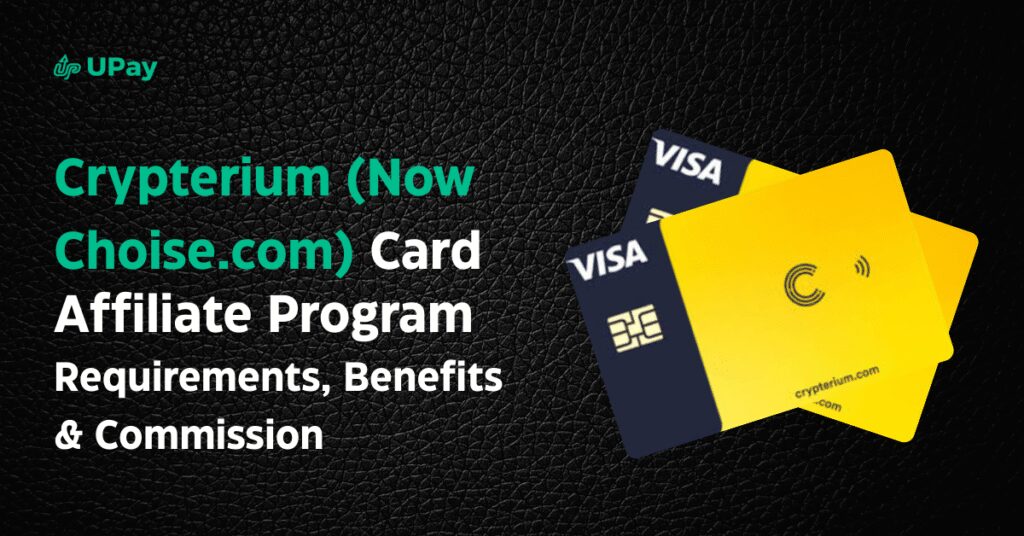
The Crypterium Card Affiliate Program (now rebranded as Choise.com) offers commissions for promoting a Visa-backed crypto card that enables crypto-to-fiat spending and in-wallet exchanges. While Choise.com focuses on serving crypto enthusiasts with a hybrid commission model, the UPay Affiliate Program delivers higher fixed earnings, broader global accessibility, and a hybrid crypto/fiat solution—making it a compelling alternative. By promoting both programs, affiliates can diversify income streams by targeting crypto natives (via Choise.com) and mainstream global users (via UPay). Key Takeaways Overview of the Crypterium (Choise.com) Card Affiliate Program Key Features of the Crypterium Card Affiliate Program Highlights While Choise.com excels in bridging CeFi and DeFi, its focus on crypto-only spending and regional restrictions can limit scalability when compared to solutions that cater to both crypto and fiat users on a global scale. Why UPay is a Competitive Alternative UPay’s affiliate program removes many of the geographic and crypto-specific limitations seen with Choise.com. Here’s what sets UPay apart: Related: MetaMask Card Affiliate Program: Comprehensive Review Participation Requirements Below is a detailed comparison of key participation requirements for both programs: Criteria Choise.com (Crypterium) UPay Residency Available in 130+ countries (with regional restrictions) Global reach in 168+ countries (excludes 30+ regions such as China, Russia, Iran, etc.) KYC Requirements Mandatory for both users & affiliates No mandatory KYC for affiliates (users complete KYC as per regulatory standards) Minimum Audience None None Supported Currencies Crypto-only (BTC, ETH, LTC) Supports over 20 cryptocurrencies and 168+ fiat currencies Payout Frequency Monthly Monthly (with tiered rewards and transparent performance metrics) Dedicated Support Basic support 24/7 VIP account managers with comprehensive marketing collateral including pre-designed templates and analytics dashboards UPay’s inclusive model and robust tools are designed to empower affiliates at every level, from novices to experienced marketers. UPay vs. Choise.com: Which is Better for Affiliates? A direct comparison highlights the key differences between the two programs: Criteria Choise.com (Crypterium) UPay Commission Structure $5 + 25% of transaction fees (for 12 months) $30 per activation + 0.6% on monthly recharge volume Global Reach Available in 130+ countries Operates in 168+ countries (with exclusions for 30+ regions) Crypto/Fiat Support Crypto-to-fiat conversion with in-wallet exchange Direct spending support for both crypto and fiat—eliminating extra conversion fees Payout Speed Monthly Monthly (with a tiered rewards system to boost high performers) Fees 0.5% gas fee on crypto-to-fiat conversions Zero transaction fees Audience Focus Crypto-native users Global audience including freelancers, travelers, businesses, and Web3 companies Dedicated Support Basic customer support 24/7 VIP account management with extensive marketing and technical support This detailed comparison underscores UPay’s flexibility, predictable earnings, and wider appeal compared to the regionally limited Choise.com model. Crypterium (Choise.com) Card 101 The Crypterium (Choise.com) Card is a Visa-linked crypto debit card designed to simplify crypto spending through a conversion process: While Choise.com offers innovative integration of CeFi and DeFi features, these limitations may restrict its adoption among mainstream users. Crypterium (Choise.com) and the Cryptocurrency Market Choise.com bridges centralized and decentralized finance by offering a hybrid crypto-to-fiat solution to its user base of over 1 million. Despite its innovative commission model and in-wallet exchange features, the reliance on crypto-to-fiat conversions, associated fees, and regional limitations may hinder mass adoption. In contrast, the global crypto card market—projected to grow at an 11.8% CAGR through 2030—requires solutions that cater to both crypto enthusiasts and traditional fiat users. UPay meets these demands with its versatile, scalable approach. UPay Affiliate Program: A Reliable Global Alternative UPay Affiliate Program Overview UPay merges the best of both crypto and traditional finance by offering a transparent and performance-driven affiliate program. The program is segmented into distinct tracks to cater to different partner profiles: Key Features How to Earn with UPay UPay’s diverse earning opportunities include: Why Choose UPay? In a rapidly evolving digital payments landscape, selecting the right affiliate program is essential. UPay stands out because: Related: Embily Card Affiliate Program: Comprehensive Review Conclusion The Crypterium (Choise.com) Card Affiliate Program is well-suited for marketers targeting crypto-native audiences with its innovative hybrid commission model and in-wallet exchange features. However, regional restrictions, conversion fees, and crypto-only limitations may impede scalability. In contrast, the UPay Affiliate Program offers a future-proof alternative with a transparent commission structure of $30 per card activation plus 0.6% on monthly recharge volume, broad global accessibility, and a flexible, multi-currency approach. By choosing UPay, affiliates gain access to a robust platform that not only supports both crypto and fiat spending but also provides extensive support, specialized partnership tracks, and additional rewards through its KOL program. Whether you’re targeting a niche crypto audience or a global mainstream market, UPay’s comprehensive and scalable affiliate model is designed to maximize your earning potential in today’s digital payments ecosystem. Frequently Asked Questions By comparing the Crypterium (Choise.com) and UPay affiliate programs, it’s clear that while Choise.com offers an innovative solution for crypto enthusiasts, UPay provides a more versatile, scalable, and globally accessible platform. Whether you’re an experienced affiliate marketer or just beginning your journey, UPay’s comprehensive approach positions you to tap into a broader market and maximize your earning potential.
Tap Card Affiliate Program: Comprehensive Review, Benefits, Requirements & Commission
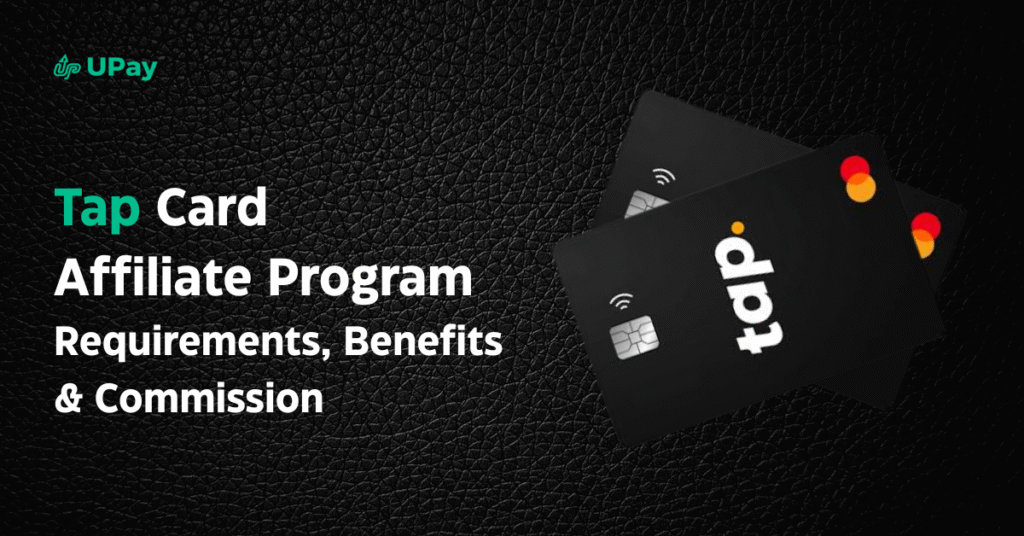
The Tap Card Affiliate Program offers a referral-based model with a one-time reward of up to $250 per user sign-up. While Tap provides a crypto-fiat prepaid Visa card with features such as a smart router for competitive exchange rates, its affiliate framework is limited to one-time rewards without recurring commissions and is geographically restricted to primarily European markets. In contrast, the UPay Affiliate Program delivers scalable, recurring revenue, global accessibility, and diversified crypto utility, making it a superior and complementary option for affiliates seeking long-term growth. Key Takeaways Overview of the Tap Card Affiliate Program Tap’s affiliate framework focuses on one-time referral bonuses with minimal recurring incentives: Commission Structure Features Critical Limitations Why UPay Beats Tap UPay’s affiliate program is built for scalability and global reach, addressing many of the limitations of the Tap Card offering: Participation Requirements: Tap vs. UPay A detailed comparison of participation criteria highlights UPay’s flexibility and transparency: Criteria Tap Card UPay Card Audience Size Requires 5,000+ followers (crypto/finance focus) None – open to all affiliates KYC Compliance Mandatory for cardholders Mandatory for card issuance Content Focus Crypto/finance focus Flexible – applicable to crypto, travel, freelancing, fintech, etc. Geographic Reach EU-centric Operates in 168+ countries (excludes 30+ regions such as China, Russia, Iran) Marketing Tools Basic referral links Comprehensive suite: banners, APIs, real-time analytics, VIP account managers, custom referral links Payout Frequency Undisclosed (likely one-time per referral) Monthly payouts with full transparency Tap Card 101: Features, Fees, and Functionality Key Features Fee Structure Limitations Tap and the Cryptocurrency Market: Position & Challenges Market Position Tap focuses on driving crypto adoption in Europe with: Challenges UPay’s Counter-Strategy UPay Affiliate Program: A Reliable Alternative UPay Affiliate Program Overview The UPay Card Affiliate Program is designed to bridge the gap between cryptocurrency and fiat transactions, offering affiliates a recurring, performance-driven commission structure. It caters to various partner categories, including: Key Features How to Earn with UPay Why Choose UPay? Conclusion While the Tap Card Affiliate Program offers high one-time referral bonuses of up to $250, its lack of recurring commissions and its EU-centric limitations restrict long-term earning potential. In contrast, the UPay Affiliate Program delivers a transparent and scalable model—with $30 per card activation plus 0.6% on monthly recharge volume, global accessibility in over 168 countries, and a versatile suite of 9 multi-currency card types—backed by robust affiliate support and advanced marketing tools. This makes UPay the superior choice for affiliates seeking to maximize revenue in the dynamic crypto-finance market. Frequently Asked Questions 1. What is the cost of joining the UPay Affiliate Program?Joining UPay’s affiliate program is completely free—there are no upfront fees or hidden costs. Simply sign up, receive your unique referral code, and start promoting. 2. How are commissions calculated?Affiliates earn a fixed $30 for every verified card activation plus an additional 0.6% commission on the monthly recharge volume generated by their referrals. Tiered rewards further boost earnings as your referral volume increases. 3. When do I get paid?UPay offers monthly payouts, ensuring you receive your earnings on a predictable schedule. You can monitor your performance in real time using UPay’s advanced analytics dashboard. 4. What marketing resources are available to affiliates?UPay provides an extensive suite of marketing tools, including pre-designed banners, custom referral links, email templates, and a real-time analytics dashboard. Dedicated VIP account managers are available 24/7 to support your promotional efforts. 5. Is there a minimum audience requirement to join UPay’s affiliate program?No, UPay is open to all affiliates—from nano-influencers to established marketers—with no minimum audience requirements. By comparing the Tap Card and UPay Affiliate Programs, it is evident that while Tap offers a high one-time referral bonus model, its lack of recurring commissions and geographic limitations significantly restrict long-term growth. UPay’s transparent commission structure, multi-currency support, global reach, and robust affiliate infrastructure make it the superior, scalable choice for affiliates aiming to maximize revenue in today’s competitive crypto-finance landscape.
Blockchain.com Visa® Card Affiliate Program: A Comprehensive Review
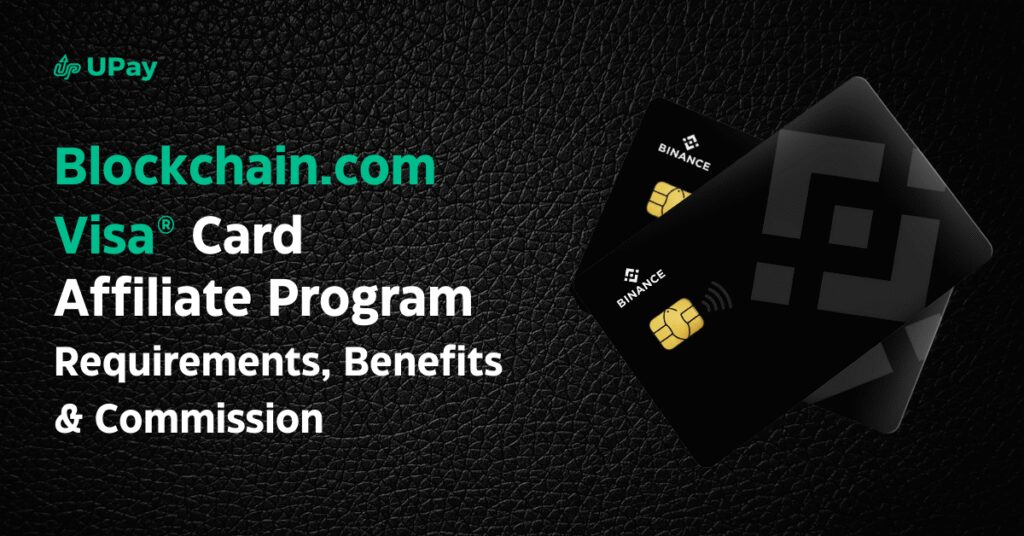
The Blockchain.com Visa® Card Affiliate Program offers crypto enthusiasts an opportunity to earn commissions by promoting a Visa-backed crypto card that enables seamless crypto-to‑fiat spending. With features like “Just-in-Time Funding” (auto-conversion of crypto to fiat at checkout via Marqeta), travel rewards, and tiered commissions of 25-50% on trading fees, Blockchain.com caters primarily to crypto purists. However, the UPay Affiliate Program stands as a competitive alternative or strategic complement, offering fixed earnings, broader crypto and fiat support, and global accessibility. By promoting both programs, affiliates can cater to dedicated crypto users as well as those seeking hybrid crypto/fiat solutions, thereby maximizing their reach and earnings. Key Takeaways By leveraging both programs, affiliates can tap into the niche crypto audience that Blockchain.com targets while also embracing a broader, global market with UPay’s hybrid approach. Related: CryptoSpend Visa Card Affiliate Program vs. UPay Affiliate Program: A Comprehensive Review Overview of the Blockchain.com Visa® Card Affiliate Program Key Features of the Blockchain.com Visa® Card Affiliate Program Highlights While Blockchain.com excels with its crypto-native features and innovative “Just-in-Time Funding” system, its strict follower requirements and exclusive focus on crypto spending may limit scalability for broader audiences. Why Consider UPay as a Competitive Alternative? The UPay Affiliate Program offers a flexible and transparent revenue model that makes it a strong alternative or complement to Blockchain.com’s offering. Here’s why: Transparent and Predictable Earnings Hybrid Crypto/Fiat Integration Diverse Card Options Global Accessibility Robust Affiliate Support Payout Consistency UPay’s transparent commission structure, diverse card options, and extensive global support make it a highly competitive alternative for affiliates looking to maximize revenue in both niche crypto and mainstream markets. Participation Requirements Below is a side‑by‑side comparison of the participation requirements for the Blockchain.com Visa® Card and UPay Affiliate Programs: Criteria Blockchain.com Visa® Card Affiliate Program UPay Affiliate Program Minimum Followers Requires 3,000+ followers (individuals) No minimum audience requirements – open to all affiliates Audience Niche Crypto-only focus Supports both crypto and traditional finance, appealing to a diverse audience Payout Threshold $100 minimum balance $50 minimum payout threshold Supported Currencies Payouts available in 46+ fiat currencies Supports 20+ cryptocurrencies plus 168+ fiat currencies Payout Frequency Monthly (approximately 30-day cycle) Monthly payouts – ensuring consistent and predictable cash flow Dedicated Support Basic affiliate support 24/7 VIP account managers, real‑time analytics dashboards, and extensive pre‑designed marketing collateral UPay’s inclusive entry requirements and robust support system empower affiliates at every level, from beginners to seasoned professionals. Related: Change Card Affiliate Program: Comprehensive Review UPay vs. Blockchain.com Visa®: Which is Better for Affiliates? The table below provides a direct comparison between the two affiliate programs: Criteria Blockchain.com Visa® Card Affiliate Program UPay Affiliate Program Commission Structure 25-50% commission on trading fees (variable, crypto-only) $30 per card activation + 0.6% on monthly recharge volumes – fixed and transparent, with tiered rewards for high performers Crypto Support Supports BTC, ETH, and USDC Supports BTC, ETH, USDT plus 20+ additional cryptocurrencies, alongside multi‑currency fiat support Global Accessibility Focused on specific regions with 46+ fiat payout options Operates in 168+ countries (excludes over 30 regions such as China, Russia, Iran, etc.) – offering a truly global market Payout Frequency Monthly (approx. 30 days) Monthly payouts – ensuring steady, predictable earnings Audience Requirements Requires a minimum of 3,000 followers (crypto-centric) No follower requirements – democratizing affiliate opportunities for all marketers Marketing Materials Provides referral links, banners, and real‑time dashboards Extensive marketing collateral, including customizable dashboards, pre‑designed templates, banners, APIs, and dedicated VIP account management Additional Perks Innovative “Just-in-Time Funding” and travel rewards; limited to crypto-only Tiered rewards, corporate vs. distributor agent tracks, and a specialized KOL Partnership Program for premium commissions and expanded market access This comparison demonstrates that while Blockchain.com targets crypto purists with its innovative features, UPay offers a versatile, transparent, and globally scalable affiliate program that can appeal to both crypto enthusiasts and mainstream users. Blockchain.com Visa® Card 101 The Blockchain.com Visa® Card enables users to convert crypto to fiat in real time, making everyday spending seamless. Here are the key details: Blockchain.com leverages Visa’s extensive network of 80M+ merchants, making it a robust solution for crypto-native users. However, its focus on crypto-only spending and strict follower requirements may restrict its appeal for a broader audience. Blockchain.com Visa® and the Cryptocurrency Market Blockchain.com is a leading crypto services provider that caters primarily to crypto purists. By integrating Visa’s vast merchant network and offering innovative features like “Just-in-Time Funding,” it has positioned itself as a valuable tool for crypto-to‑fiat spending. Nevertheless, the lack of fiat integration and stringent affiliate requirements (such as a minimum of 3,000 followers) can limit its scalability for mainstream adoption. As the global crypto card market is projected to grow at an 11.8% CAGR through 2030, there is a growing demand for solutions that bridge the gap between crypto and traditional finance. UPay Affiliate Program: A Reliable Alternative UPay merges the agility of crypto with the reliability of traditional finance. Its affiliate program is designed for transparency, global scalability, and versatility. Earning Tiers and Structure Key Features How to Earn with UPay Earning with UPay is designed to be straightforward and scalable: Why Choose UPay? UPay’s affiliate program stands out for its clarity, versatility, and global reach. Here’s why you should consider adding UPay to your affiliate portfolio: Conclusion The Blockchain.com Visa® Card Affiliate Program is tailored for crypto purists, offering features like “Just-in-Time Funding,” tiered commissions on trading fees, and travel rewards. However, its focus on crypto-only spending and strict follower requirements may restrict its appeal for a broader, mainstream audience. In contrast, the UPay Affiliate Program provides a competitive, versatile alternative with a fixed commission structure of $30 per card activation plus 0.6% on monthly recharge volumes. With its extensive portfolio of 9 card types, global accessibility in 168+ countries (excluding over 30 regions for regulatory reasons), and robust affiliate support—including VIP account managers, customizable marketing collateral, and a tiered rewards system—UPay is well positioned to serve a diverse audience ranging from individual consumers to large enterprises and innovative Web3 companies.
Uphold Card Affiliate Program: Comprehensive Review, Benefits, Requirements & Commission
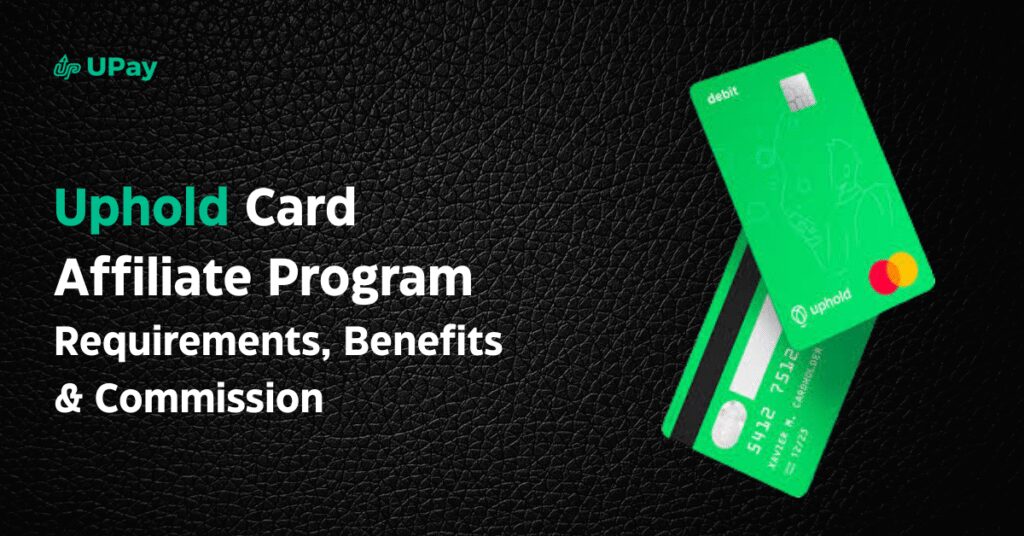
The Uphold Card Affiliate Program enables marketers to earn by promoting a multi-currency crypto debit card. Uphold excels at offering a flexible spending solution with features like 50% revenue share for the first three months, 4% XRP cashback on purchases, and “anything-to-anything” trading between crypto, fiat, and commodities. However, when comparing it with the UPay Affiliate Program, affiliates have an attractive alternative or strategic complement that offers fixed earnings, broader accessibility, and a hybrid crypto/fiat model. By promoting both, affiliates can target crypto enthusiasts (via Uphold) as well as global mainstream users (via UPay), thereby diversifying their revenue streams. Key Takeaways By leveraging both programs, affiliates can maximize their earning potential by targeting niche crypto audiences with Uphold and a broader international market with UPay. Overview of the Uphold Card Affiliate Program Key Features of the Uphold Card Affiliate Program Highlights While Uphold’s innovative multi-asset platform and attractive cashback rewards make it appealing for a crypto-heavy audience, it does require affiliates to maintain an active online presence to tap into its niche market. Why Consider UPay as a Competitive Alternative? UPay’s Affiliate Program provides a compelling option for affiliates looking for predictable earnings, global scalability, and enhanced support. Here’s why UPay is worth considering alongside Uphold: UPay’s features make it an attractive, competitive alternative to Uphold, allowing affiliates to diversify their income streams and appeal to a global audience. Participation Requirements Below is a side‑by‑side comparison of the participation requirements for the Uphold and UPay Affiliate Programs: Criteria Uphold Card Affiliate Program UPay Affiliate Program Minimum Audience Requires an active online presence (blogs, social media, communities) No minimum audience requirements—open to all affiliates KYC Requirements Mandatory for referrals (ID verification required) Mandatory for cardholders; streamlined for affiliates Payout Threshold $100 minimum balance No minimum payout threshold Supported Currencies Supports 27 cryptocurrencies, fiat, and commodities Supports 20+ cryptocurrencies and 168+ fiat currencies Payout Frequency Monthly (approximately 30-day cycle) Monthly payouts— ensuring consistent, predictable cash flow Dedicated Support Basic affiliate support 24/7 VIP account managers, real-time analytics dashboards, and extensive pre-designed marketing collateral UPay’s inclusive entry requirements and enhanced support make it accessible and effective for affiliates at all levels. UPay vs. Uphold: Which is Better for Affiliates? A direct comparison between the two programs highlights their respective strengths: Criteria Uphold Affiliate Program UPay Affiliate Program Commission Structure 50% revenue share for the first 3 months; additional CPA options $30 per card activation + 0.6% on monthly recharge volumes – fixed, transparent, with tiered rewards for high performers Crypto/Fiat Support Focuses primarily on crypto and commodities Supports both crypto and fiat with multi‑currency capabilities, covering 20+ cryptocurrencies and 168+ fiat currencies Global Reach Limited to certain regions (regional restrictions apply) Operates in 168+ countries, excluding over 30 regions (e.g., China, Russia, Iran) for regulatory compliance Payout Frequency Approximately 30-day cycle Monthly payouts – ensuring regular, predictable income Fees 1.25% spread fee + ATM withdrawal fees Zero transaction fees – a fee advantage enhancing overall value Cashback/Bonuses 4% XRP cashback on purchases Volume-based bonuses and tiered rewards for high-performing affiliates Marketing Materials Banners, text links, landing pages Customizable dashboards, pre‑designed templates, APIs, and dedicated VIP support This comparison shows that while Uphold targets crypto-savvy users with unique rewards such as XRP cashback, UPay offers a highly transparent, versatile, and globally scalable affiliate program that appeals to a wider range of audiences. Uphold Card 101 The Uphold Card is a Mastercard-linked debit card designed for spending across multiple asset classes—including crypto, fiat, and commodities. Here are the key details: Uphold caters to multi-asset traders and crypto enthusiasts, but its focus on a crypto-heavy user base and regional limitations may restrict its appeal among mainstream audiences. Uphold and the Cryptocurrency Market Uphold is designed for multi-asset traders, offering unique “anything-to-anything” swaps between 27 cryptocurrencies, commodities, and U.S. equities. With a user base of over 7 million globally and consumer spending via crypto cards exceeding $2.5B in Q1 2022, Uphold has established a strong niche in the market. However, its limited fiat flexibility and relatively high spread fees may hinder broader adoption among everyday users. UPay Affiliate Program: A Reliable Alternative UPay bridges the gap between crypto and traditional finance with an affiliate program built for transparency and global scalability. Key highlights include: Earning Tiers and Structure Key Features How to Earn with UPay Earning with UPay is designed to be straightforward and adaptable to various promotional strategies: Why Choose UPay? UPay’s affiliate program stands out due to its transparency, global scalability, and comprehensive support. Here’s why affiliates should consider integrating UPay into their strategy: Conclusion The Uphold Card Affiliate Program is ideal for marketers targeting crypto-savvy audiences, offering unique multi-asset capabilities, attractive XRP cashback, and versatile spending options. However, its focus on crypto-heavy users, regional restrictions, and fee structures may limit its scalability for mainstream markets.In contrast, the UPay Affiliate Program provides a competitive, versatile alternative with fixed commissions of $30 per activation plus 0.6% on monthly recharge volumes. UPay’s extensive portfolio of 9 card types, global accessibility in 168+ countries (with regulatory-compliant exclusions), and robust affiliate support—including dedicated VIP managers, customizable marketing collateral, and tiered rewards—empower affiliates to reach diverse audiences ranging from individual consumers to corporate clients and Web3 companies.
hi.com Card Affiliate Program: A Comprehensive Review

The hi.com Card Affiliate Program offers a niche opportunity for promoting a hybrid crypto-fiat debit card that features unique perks like NFT customization and tiered membership rewards. Despite its attractive features—such as up to 12% cashback for premium tiers—the program lacks a formal affiliate structure, recurring commissions, and has geographic limitations (focusing mainly on SEPA regions). In contrast, the UPay Affiliate Program provides a transparent, scalable, and globally accessible solution with robust long-term rewards and advanced affiliate tools, making it an ideal alternative or complement for affiliates seeking to maximize earnings in the crypto-finance space. Key Takeaways Read Also: Ledger & Banx CL Card Affiliate Program vs. UPay Affiliate Program Overview of the hi.com Card Affiliate Program hi.com positions its card as a hybrid solution that blends crypto and fiat functionalities with unique customization options. However, the affiliate aspect of the program remains informal and limited. Commission Structure & Rewards Features Critical Limitations Why UPay Trumps hi.com UPay’s affiliate program addresses many of the limitations found in the hi.com Card offering, delivering both transparency and scalability: Participation Requirements: hi.com vs. UPay A detailed comparison of participation criteria further highlights the flexibility and transparency of UPay’s program: Criteria hi.com Card UPay Card Audience Size Requires crypto-focused platforms (primarily EU) None – open to all affiliates KYC Compliance Mandatory for cardholders Mandatory for card issuance Content Guidelines Focused on crypto and finance Flexible – applicable to crypto, travel, freelancing, fintech, etc. Geographic Reach SEPA regions (EU-centric) Operates in 168+ countries (excludes 30+ regions like China, Russia, Iran) Marketing Tools Limited (only basic referral links) Comprehensive tools including banners, APIs, real-time analytics, VIP account managers, and custom links Payout Frequency Undisclosed Monthly payouts with transparent tracking hi.com vs. UPay: Which is Better for Affiliates? Criteria hi.com Card UPay Commission Model Hypothetical tier-based referrals (one-time €30 + €10 bonus) $30 per card activation + 0.6% on monthly recharge volume Earning Potential Limited to initial rewards with no recurring income Recurring, scalable earnings with tiered rewards for high performers Supported Assets Primarily EUR and major cryptocurrencies Supports BTC, ETH, USDT, EUR, GBP, and 10+ other cryptocurrencies Card Types Hybrid crypto-fiat Visa card with NFT customization Offers virtual and physical Mastercard options with ATM access across 9 versatile card types Fees Undisclosed forex/ATM fees; 1.5% forex markup on transactions Transparent fee structure: Approximately 1% cross-border, 0% issuance fee, and volume discounts available Rewards Up to 12% cashback (user-only, tied to HI token) Tiered cashback options plus potential for corporate bonuses (up to $15K/month) Compliance Limited disclosures; token-dependent Fully licensed and compliant, ensuring robust security and regulatory adherence UPay’s comprehensive, transparent, and globally scalable model clearly offers greater long-term earning potential and flexibility for affiliates compared to hi.com’s limited, EU-centric approach. hi.com Card 101: Features, Fees, and Functionality Membership Tiers Tier Cashback Stake Requirement Perks Basic 5% None PVC card, Spotify rebate Silver 8% 10,000 HI Metal card, Netflix rebate Gold 10% 50,000 HI Polished metal, hotel credits Diamond 12% 250,000 HI Diamond-encrusted card Fee Structure Limitations hi.com and the Cryptocurrency Market: Position & Challenges Market Position hi.com targets crypto users within the EU by offering a hybrid card that enables spending crypto as EUR and features personalized NFT customization. Its tiered cashback model, linked to staking HI tokens, appeals to premium users but remains highly token-dependent. Challenges UPay’s Counter-Strategy UPay Affiliate Program: A Reliable Alternative UPay Affiliate Program Overview The UPay Card Affiliate Program is designed to bridge the gap between cryptocurrency and fiat transactions by offering a clear, performance-driven commission structure. The program is structured to cater to a diverse range of partners, including: Key Features How to Earn with UPay Read Also: Trustee Payment Card Affiliate Program vs. UPay Affiliate Program: A Comprehensive Review Why Choose UPay? Conclusion While the hi.com Card Affiliate Program offers niche appeal through its innovative NFT customization and tiered cashback rewards, its limitations—such as the absence of a formal affiliate structure, lack of recurring commissions, and geographic restrictions—severely constrain long-term earning potential. In contrast, the UPay Affiliate Program delivers a transparent and scalable model with $30 per card activation plus 0.6% on monthly recharge volume, global accessibility in over 168 countries, and a versatile suite of 9 multi-currency card types. Coupled with robust affiliate support, specialized partnership tracks, and a KOL Partnership Program, UPay stands out as the superior, future-proof solution for affiliates looking to maximize revenue in today’s dynamic crypto-finance landscape. Frequently Asked Questions
Bitmama Card Affiliate Program: Comprehensive Review, Benefits, Requirements & Commission
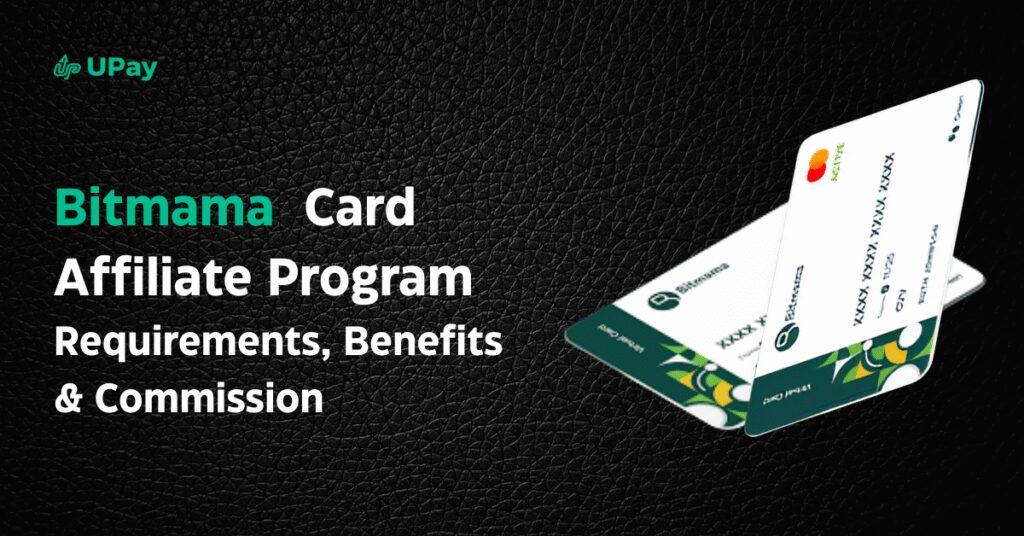
Bitmama’s affiliate program targets African crypto users by offering commissions on referrals for its Africa-focused Visa card and exchange services. While Bitmama provides crypto rewards with real-time payouts and a three-year commission duration, its opaque commission percentages and regional focus limit scalability. In contrast, the UPay Affiliate Program delivers clear, attractive earnings, global scalability, and a suite of hybrid crypto/fiat features, making it an ideal alternative or complement for affiliates seeking long-term growth. Key Takeaways Overview of the Bitmama Card Affiliate Program Bitmama’s affiliate program is geared toward promoting its Africa-focused crypto card and exchange services. Here’s what you need to know: Key Features of the Bitmama Card Affiliate Program Highlights Participation Requirements Criteria Bitmama Card UPay Card KYC/AML Compliance Required for account creation Mandatory for card activation Minimum Payout Not specified None Application Process Instant via Bitmama account Instant online approval Audience Requirements Geared toward African-focused platforms None – open to affiliates worldwide Geographic Restrictions Primarily Africa Operates in 168+ countries (excludes 30+ regions such as China, Russia, Iran) Payout Frequency Real-time (crypto payouts) Monthly payouts (in crypto/fiat) Bitmama’s regional focus and undisclosed payout metrics may limit its appeal compared to UPay’s inclusive, transparent approach. UPay vs. Bitmama: Which is Better for Affiliates? Criteria Bitmama UPay Commission Model Undisclosed percentage on referral transactions with a three-year duration $30 per card activation + 0.6% on monthly recharge volume Earning Potential Unpredictable due to opaque structure Scalable and predictable with tiered rewards for high performers Global Accessibility Primarily Africa Operates in 168+ countries with support for over 12 currencies Payout Clarity Real-time crypto payouts but opaque overall Transparent monthly payouts with clear metrics Security & Protection Basic crypto protections; lacks insured balances Offers insured balances and advanced fraud monitoring Affiliate Tools Basic promotional materials Comprehensive suite including real-time dashboards, pre-designed templates, custom referral links, and VIP support Market Focus Primarily African crypto traders Caters to a global audience including freelancers, SMEs, crypto traders, and mainstream users UPay clearly outshines Bitmama in terms of transparency, global reach, and structured, scalable earnings. Bitmama Card 101 Core Features Use Cases Bitmama and the Cryptocurrency Market Market Position Bitmama is a prominent African crypto platform competing with regional players like Yellow Card and Patricia. Its key differentiators include: Industry Trends & Challenges UPay Affiliate Program: A Reliable Alternative UPay Affiliate Program Overview UPay seamlessly bridges crypto and traditional finance, offering a clear, performance-driven commission structure and catering to a global market. It features multiple tracks to suit diverse partner profiles: Key Features How to Earn with UPay Why Choose UPay? Conclusion While Bitmama’s crypto card and exchange services are well-tailored for African markets—with features like real-time crypto payouts and a three-year commission duration—its opaque commission model and regional limitations can hinder scalability. In contrast, the UPay Affiliate Program offers a transparent commission structure of $30 per activation plus 0.6% on monthly recharge volume, global accessibility in over 168 countries, and a suite of versatile multi-currency card offerings. Coupled with robust affiliate support—including corporate/distributor tracks, VIP account managers, advanced marketing collateral, and a KOL Partnership Program—UPay emerges as the superior choice for affiliates aiming to maximize revenue in both traditional and crypto markets. Frequently Asked Questions 1. What is the cost of joining the UPay Affiliate Program?Joining UPay’s affiliate program is completely free—there are no upfront fees or hidden costs. Simply sign up, receive your unique referral code, and start promoting. 2. How are commissions calculated?Affiliates earn a fixed $30 for every verified card activation plus an additional 0.6% commission on the monthly recharge volume generated by their referrals. Tiered rewards further enhance earnings as referral volumes grow. 3. When do I get paid?UPay offers monthly payouts, ensuring you receive your earnings on a predictable schedule. You can track your performance in real time using UPay’s advanced analytics dashboard. 4. What marketing resources are available to affiliates?UPay provides an extensive suite of marketing tools, including pre-designed banners, custom referral links, email templates, and a real-time analytics dashboard. Dedicated VIP account managers are available 24/7 to assist with your promotional efforts. 5. Is there a minimum audience requirement to join UPay’s affiliate program?No, UPay is open to all affiliates—from nano-influencers to established marketers—without any minimum audience requirements. By comparing the Bitmama Card and UPay Affiliate Programs, it is clear that while Bitmama is tailored for African markets with notable features such as a three-year commission duration and real-time crypto payouts, its opaque commission details and regional limitations restrict broader growth. UPay, with its transparent $30 activation fee plus 0.6% monthly recharge commission, global accessibility, versatile 9-card offering, and robust affiliate support, stands out as the superior, scalable choice for affiliates aiming to maximize revenue in today’s dynamic financial landscape.

